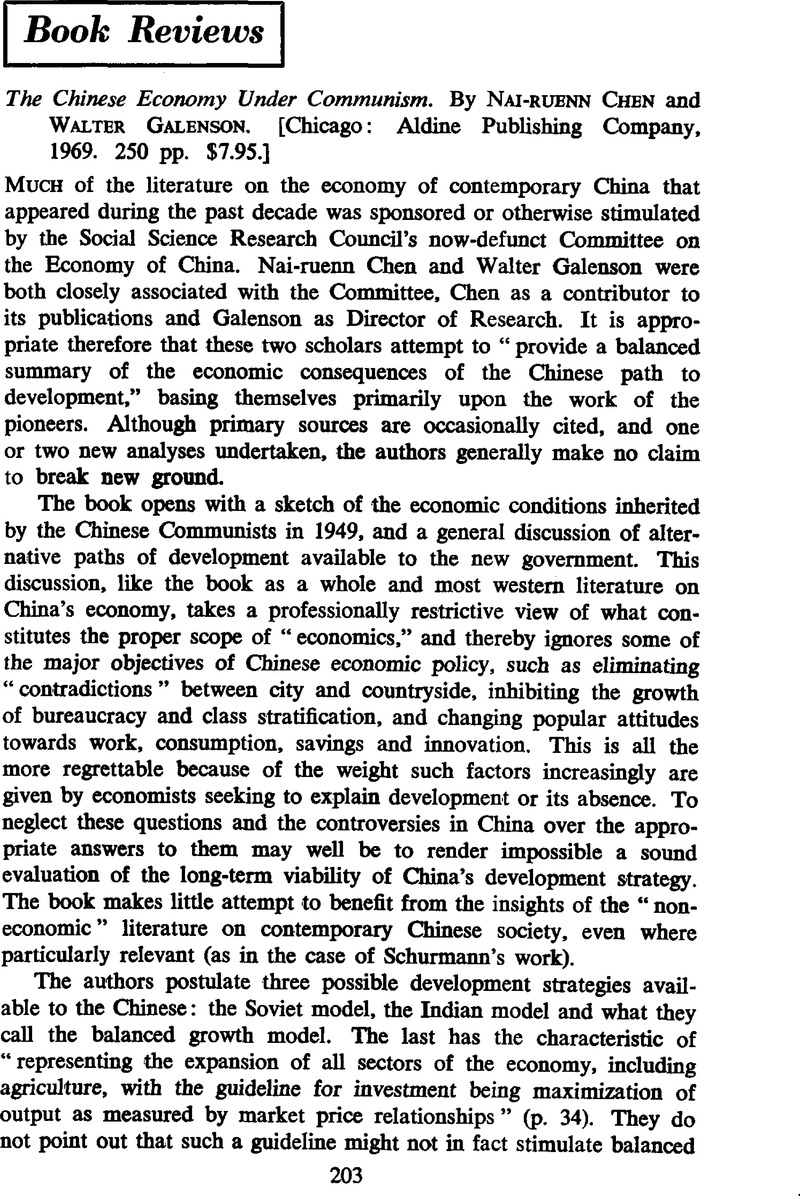No CrossRef data available.
Published online by Cambridge University Press: 17 February 2009

1 See Chao's, Kang testimony in U.S. Congress, Joint Economic Committee, Mainland China in the World Economy (Washington, D.C. 1967)Google Scholar; also, Perkins, Dwight, “Economic Growth in China and Cultural Revolution (1960–April 1967),” The China Quarterly, No. 30 (04–06 1967)CrossRefGoogle Scholar. Field has recently published a revised index which encompasses these criticisms. See his “Industrial Production in Communist China: 1957–1968,” The China Quarterly, No. 42 (04–06 1970).Google Scholar
2 Foodgrain production estimates for the first half of the 1960s, given to a visiting Pakistani delegation by officials of the Ministry of Agriculture in Peking, have been published since this book appeared. Substantially higher than any alternative, they imply a correspondingly greater efficacy for China's agricultural policies. See Swamy, S. and Burki, S., “Foodgrains Output in the People's Republic of China, 1958–1965,” The China Quarterly, No. 41 (01–03 1970).CrossRefGoogle Scholar
3 If the estimates presented by Swamy and Burki are used, the resulting growth rate is 8 per cent. per year, which, although very high, is perhaps not out of the question for years of recovery.Google Scholar
4 It is reported that China probably imported 6 million tons (ammonium sulphate equivalent) in 1969 at a total cost of about $190 million. Current Scene (Hong Kong: United States Information Service), Vol. VIII, No. 11 (1 06 1970), p. 16.Google Scholar
5 It should be pointed out also that statistics for chemical fertilizer production obtained in China by S. Burki are substantially higher (by 72 per cent. for 1964, the last year listed by Burki) than those used by Chen and Galenson. See Burki, S. J., A Study of Chinese Communes 1965 (Harvard Monograph Series, Cambridge, Mass., 1969), p. 6.CrossRefGoogle Scholar
6 See Galenson, W. and Leibenstein, H., “Investment Criteria, Productivity and Economic Development,” Quarterly Journal of Economics (Boston), 08 1955, for a classic statement of a particular case against stressing labour-intensive methods in the process of development.Google Scholar
7 Chih-ta, Ko, Kuo-tu shih-ch'i ti Chung-kuo yü-suan (China's Budget in the Transition Period) (Peking, 1957), p. 120Google Scholar; Donnithorne, Audrey, China's Economic System (London, 1967), pp. 184–185Google Scholar, 387; and “Decisions on Employment of the Government Administration Council of the Central People's Government,” in Labour Laws and Regulations of the People's Republic of China (Peking: Foreign Languages Press, 1956).Google ScholarPubMed
8 Field, Robert M., “Chinese Communist Industrial Production,” An Economic Profile of Mainland China (Washington, D.C., 1967), p. 275.Google Scholar
9 On this subject and, more specifically, on the effects of the “green revolution” in aggravating social inequalities in the Indian countryside, see Frankel, Francine, “India's New Strategy of Agricultural Development: Political Costs of Agrarian Modernization,” Journal of Asian Studies (New York), 08 1969Google Scholar; and Ladejinsky, Wolf, “Ironies of India's Green Revolution,” Foreign Affairs (New York), 07 1970.Google Scholar